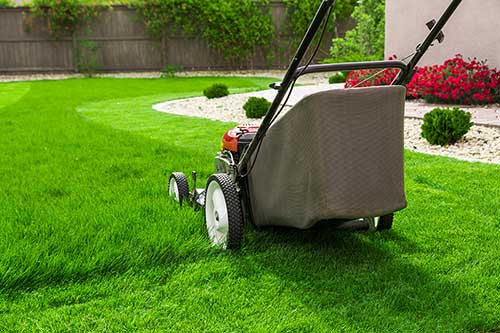Caring for your fescue lawn
Jul 01, 2019

July is a tough month for fescue lawns in our area due to the typical hot, dry conditions. Here are a few tips to keep your lawn healthy in the summer heat.
Mowing
Mow to 3 ½ inches and before the grass gets taller than 5 inches. Don’t cut more than 1/3 of the grass blade’s height when mowing. Cutting more off the blade at one time will deplete the plant’s energy reserves.
Fertilization
Do NOT fertilize tall fescue at this time. The root system is limited in its uptake ability and there is no need to stimulate this cool-season grass when its stressed from high temperatures. It is also recommended not to aerate tall fescue lawns at this time.
Watering
Water as needed to prevent drought stress. About 1 inch of water once a week is adequate for irrigated lawns. Sandy soils often require more frequent watering, about ½ inch every third day.
Disease Control
Tall fescue is highly susceptible to brown patch disease. If you see small, tan spots with brown borders, your fescue may have brown spot. This will eventually cause large brown areas in your lawn. If the lawn is infested, apply a fungicide according to package directions, and alternate with different types of fungicide.
Weed Control
It is NOT recommended to apply herbicides during this time.
Insect Control
Be sure to check your lawn for white grubs in July. If you have brown spots, grab a handful of brown grass and pull. If the turf pulls up like a carpet, inspect the soil surface for small grubs. Small populations of grubs are normal and will not stress your lawn. However, larger infestations can do a lot of damage to turf. Check with your local Co-op for insecticides to treat your lawn.
Soil Testing
Contact your local Co-op about soil testing at the end of the summer to determine which nutrients are needed for fall fertilization.
Mowing
Mow to 3 ½ inches and before the grass gets taller than 5 inches. Don’t cut more than 1/3 of the grass blade’s height when mowing. Cutting more off the blade at one time will deplete the plant’s energy reserves.
Fertilization
Do NOT fertilize tall fescue at this time. The root system is limited in its uptake ability and there is no need to stimulate this cool-season grass when its stressed from high temperatures. It is also recommended not to aerate tall fescue lawns at this time.
Watering
Water as needed to prevent drought stress. About 1 inch of water once a week is adequate for irrigated lawns. Sandy soils often require more frequent watering, about ½ inch every third day.
Disease Control
Tall fescue is highly susceptible to brown patch disease. If you see small, tan spots with brown borders, your fescue may have brown spot. This will eventually cause large brown areas in your lawn. If the lawn is infested, apply a fungicide according to package directions, and alternate with different types of fungicide.
Weed Control
It is NOT recommended to apply herbicides during this time.
Insect Control
Be sure to check your lawn for white grubs in July. If you have brown spots, grab a handful of brown grass and pull. If the turf pulls up like a carpet, inspect the soil surface for small grubs. Small populations of grubs are normal and will not stress your lawn. However, larger infestations can do a lot of damage to turf. Check with your local Co-op for insecticides to treat your lawn.
Soil Testing
Contact your local Co-op about soil testing at the end of the summer to determine which nutrients are needed for fall fertilization.